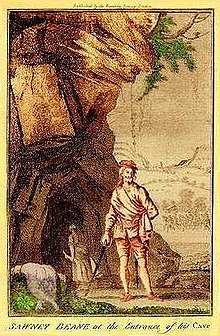Sawney Bean
| Sawney Bean | |
|---|---|

Sawney Bean at the Entrance of His Cave. Note the woman in the background carrying a dismembered leg.
|
|
| Born |
Alexander Bean East Lothian, Scotland |
| Other names | Sawney |
| Children | 14. |
Alexander "Sawney" Bean was said to be the head of a 48-member clan in Scotland anywhere between the 13th and 16th centuries, reportedly executed for the mass murder and cannibalisation of over 1,000 people.
The story appears in The Newgate Calendar, a crime catalogue of Newgate Prison in London. While historians tend to believe Bean never existed or his story has been greatly exaggerated, his story has passed into local folklore and become part of the Edinburgh tourism industry.
According to The Newgate Calendar, Alexander Bean was born in East Lothian during the 1500s. His father was a ditch digger and hedge trimmer, and Bean tried to take up the family trade but quickly realized that he had little taste for honest labour.
He left home with a vicious woman who apparently shared his inclinations. The couple ended up at a coastal cave in Bennane Head between Girvan and Ballantrae where they lived undiscovered for some twenty-five years. The cave was 200 yards deep and during high tide the entrance was blocked by water.
The couple eventually produced eight sons, six daughters, eighteen grandsons and fourteen granddaughters. Various grandchildren were products of incest. Lacking the inclination for regular labour, the clan thrived by laying careful ambushes at night to rob and murder individuals or small groups. The bodies were brought back to the cave, where they were dismembered and eaten. Leftovers were pickled, and discarded body parts would sometimes wash up on nearby beaches.
The body parts and disappearances did not go unnoticed by the local villagers, but the Beans stayed in the caves by day and took their victims at night. The clan was so secretive that the villagers were unaware of the murderers living nearby.
As more significant notice of the disappearances was taken, several organised searches were launched to find the culprits. One search took note of the telltale cave but the men refused to believe anything human could live in it. Frustrated and in a frenetic quest for justice, the townspeople lynched several innocents, and the disappearances continued. Suspicion often fell on local innkeepers since they were the last known to see many of the missing people alive.
...
Wikipedia
